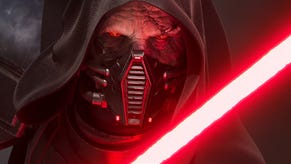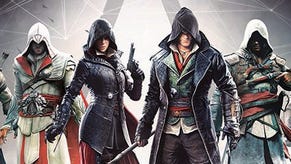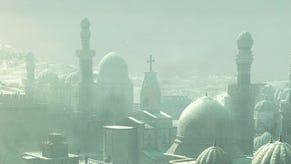Assassin's Creed: Brotherhood
Free Rome.
An assassin's work - a bit like a postman's perhaps - is never done. Ezio Auditore's only just got back to his villa after prosecuting that whole blood-soaked vengeance deal at the end of Assassin's Creed II, and all of us a sudden there's cannon-fire shredding his bedroom as he tries to enjoy himself with a friendly lady. What a drag.
Luckily, it means that Assassin's Creed: Brotherhood kicks off in astonishing style, with Ezio staggering out onto the roof of his mansion to see 30,000 NPCs (full-disclosure: that's what the producer said; I didn't have time to count them) flocking over the hill. It's the Templars, out in force, and ready to do a little home-wrecking.
Not before a few mechanical tweaks have been introduced, mind you. The first few minutes of Brotherhood are filled with frantic spectacle as you're flung into Ezio's fancy boots just in time to receive orders from Uncle Mario - that still sounds weird - to hold off the attackers long enough to give the villa's staff time to get to safety.
That means using a cannon on the battlements to break up the advancing siege towers - and that, in turn, means an on-horseback dash through the streets surrounding the villa while Renaissance architecture comes toppling down all around you. If you spent a lot of time in the last game making your home look pretty, Ubisoft only needs 30 seconds or so to reduce it to rubble again.
Horses will be a big feature of Brotherhood, as it happens. You'll be able to use them inside cities for the first time - racing through narrow streets looks reassuringly brilliant - and there's plenty of horse-based combat, as you use melee and ranged attacks from the saddle, and sample the pleasures offered by cutting an enemy's ride out from under them with a flash of steel.
Combat's been retooled even when you're on foot, as Ezio's eventual arrival on the battlements reveals. After the heavily counters-based focus of first two games, the team's mantra for Brotherhood is "Strike first, strike fast".
What this translates to in terms of swordplay is enemies who don't wait for their moment to attack you (unlike the previous game's villains, who would loiter politely, as though they were queuing up at a Waitrose cheese counter) and a much stronger emphasis on running people through the gut before they've laid a hand on you. Meanwhile, the animation, as ever with this series, can turn even the lamest of street scraps into something that looks thrilling and dramatic.
Before the introduction fades, you'll have had time to try out new cannons - you select a distant target and then watch with pleasure as a siege tower (or unfortunate barn) splinters cinematically under the force of your blow - and then an old friend is killed by Brotherhood's main villain, Ceasare, and the game starts for real.
At the moment, Ubisoft is only offering the tiniest glimpse of the game lurking beyond the hectic opener, but it seems, above all else, to be a genuine companion piece to Assassin's Creed II. Ezio may be back, but this is a fascinating variation on his earlier adventures, and while the trappings are familiar, the emphasis is all new. So if the earlier game was all about becoming a master assassin, this one's about what it's like to actually be one; if the last one was concerned with revenge, the second revolves around justice.
It also revolves around squads, but you'll rarely find yourself thinking about them that way. The latest game's main storyline quickly dumps you into a Rome made tatty by Templar rule. It's 1503, there's fear in streets and disco in the clubs, and Ezio's job is to form his own assassin's guild - a brotherhood that will clean up the city and bring hope to the populace in the process.










.png?width=291&height=164&fit=crop&quality=80&format=jpg&auto=webp)




.jpg?width=291&height=164&fit=crop&quality=80&format=jpg&auto=webp)
